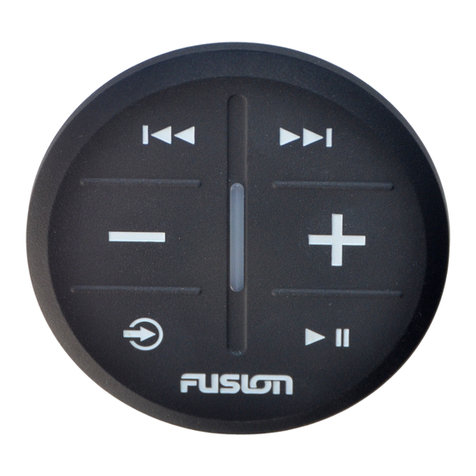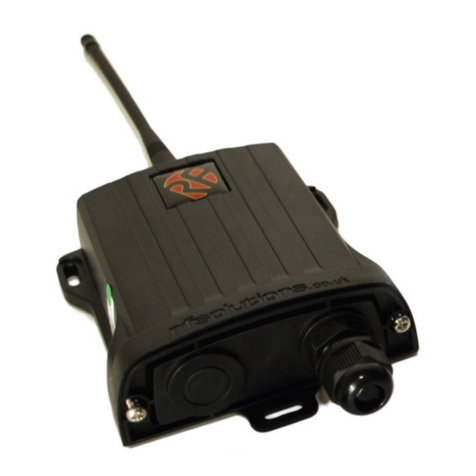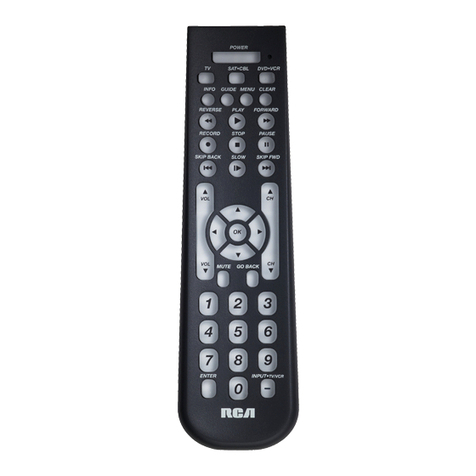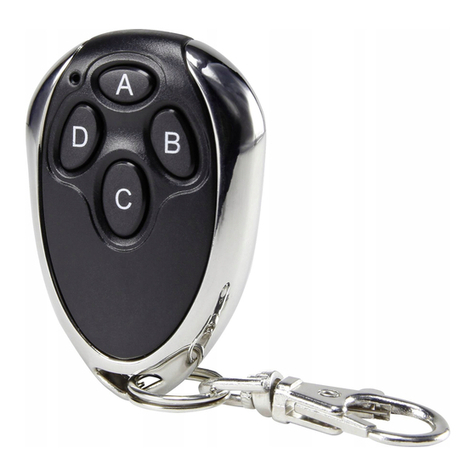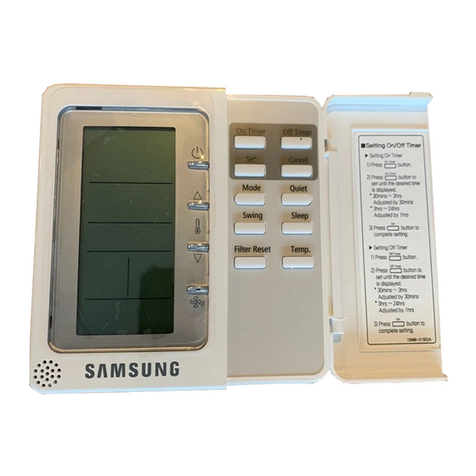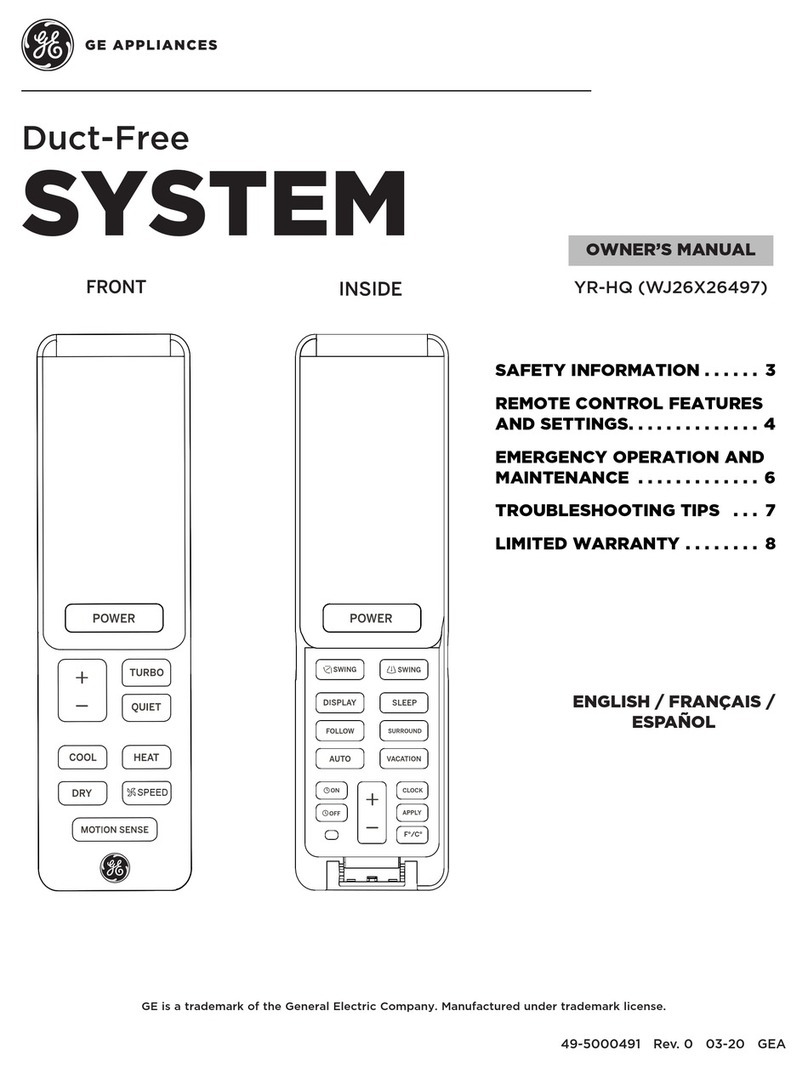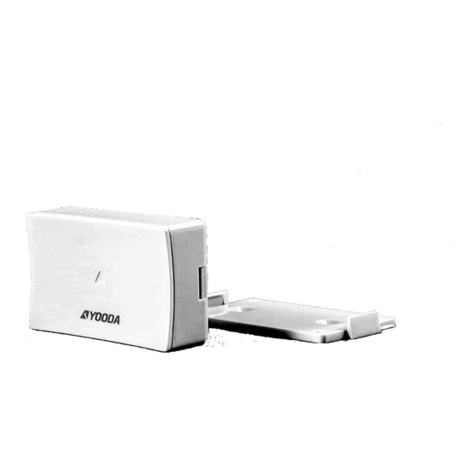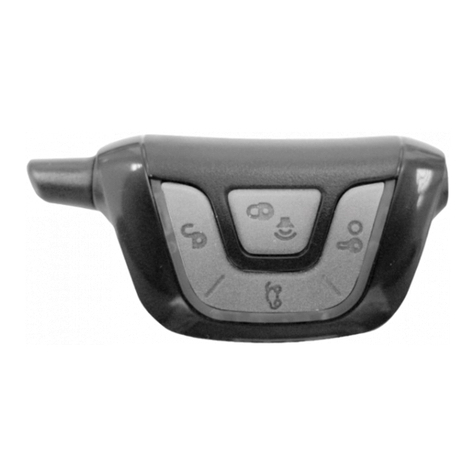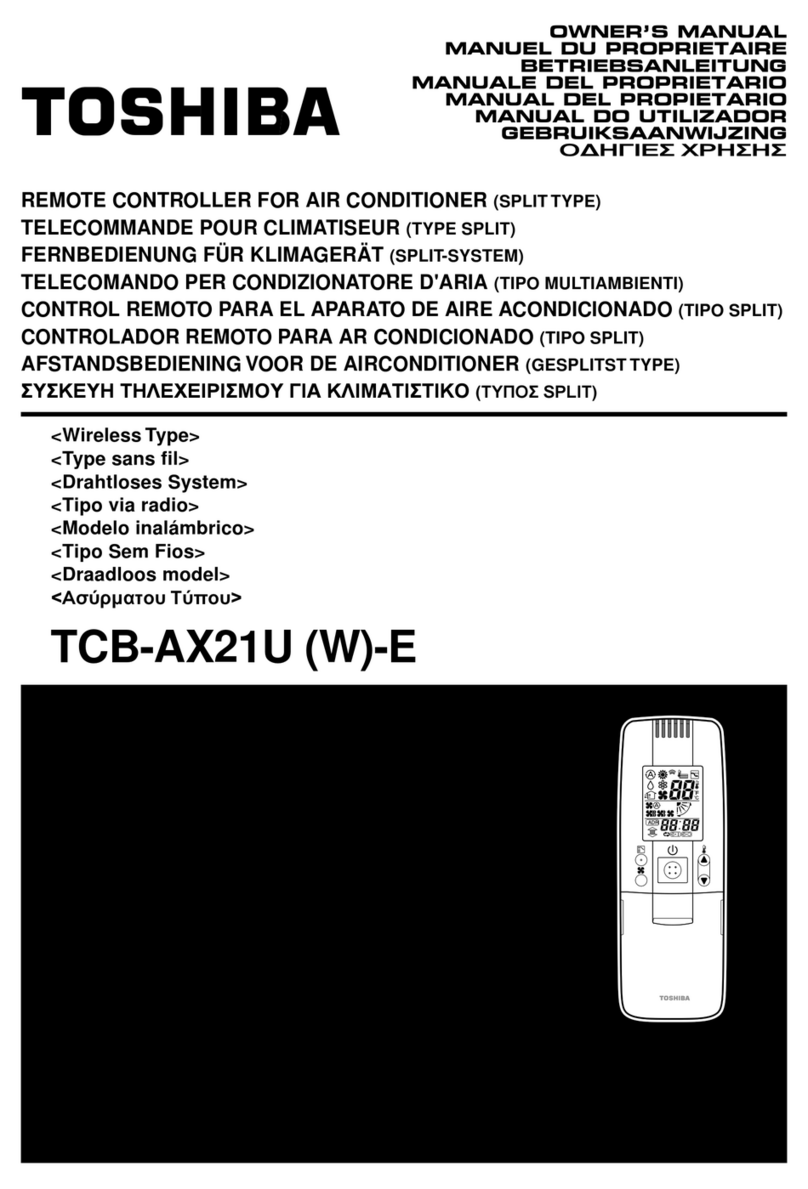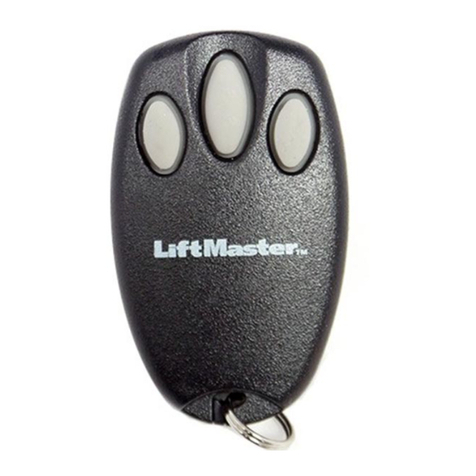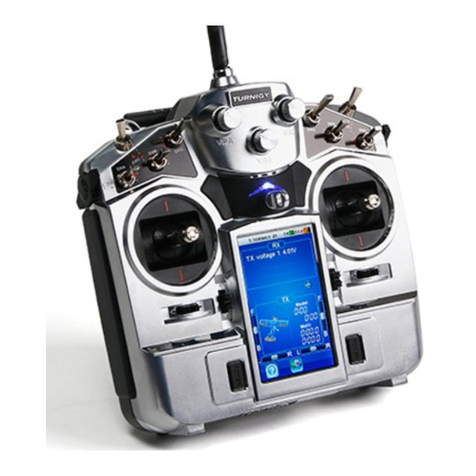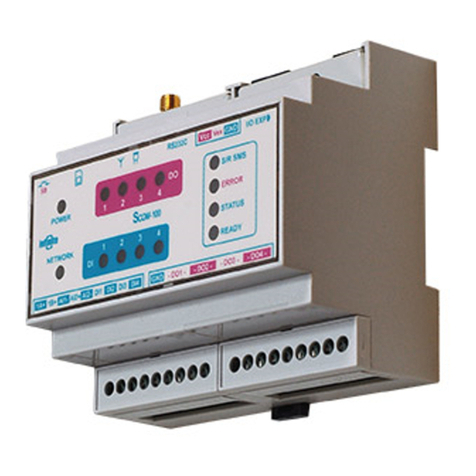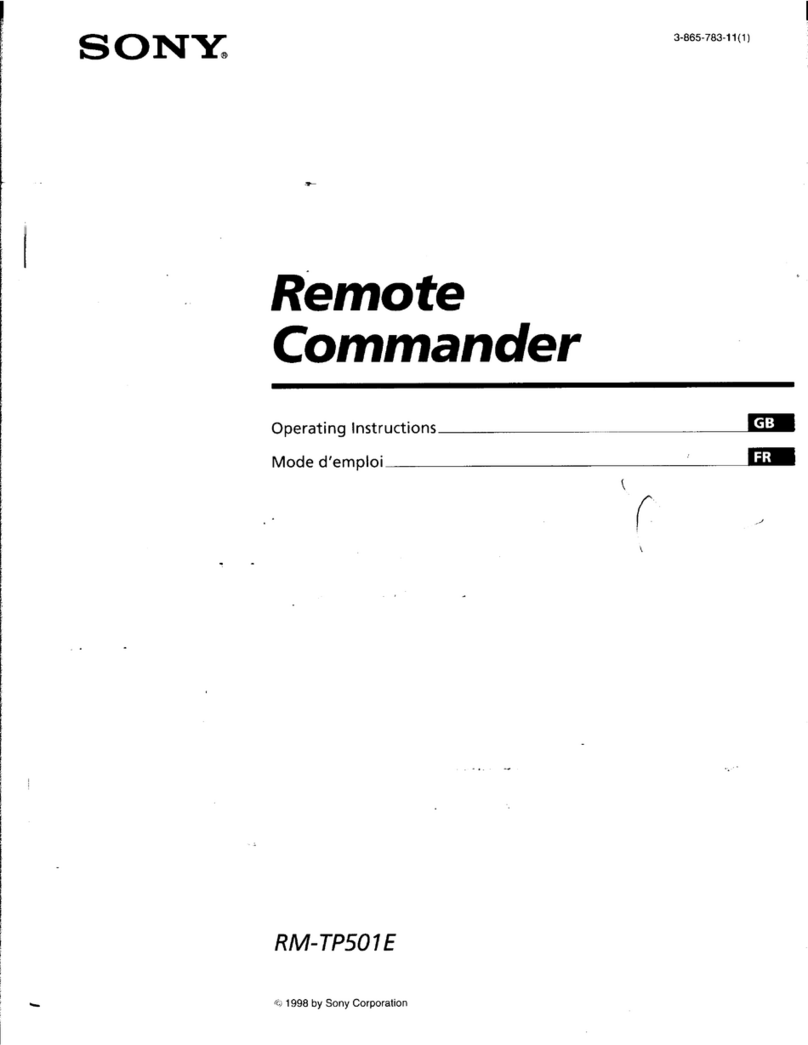FMI (C)MRC User manual

With the slide switch in the OFF position (sway
from the LEARN button), the system is off.
It is suggested that the slide switch be placed
in the OFF position if you will be away from
the home for an extended period of time. If the
remote receiver is mounted out of the reach
of children, place the slide switch in the OFF
position also functions as a safety "lock-out"
by both turning the system off and rendering
the remote receiver inoperative.
(C)MRC
ON / OFF REMOTE CONTROL
FOR USE IN FMI PRODUCTS, LLC MANUFACTURED
"REMOTE READY" GAS HEARTH PRODUCTS
The remote operated on a 12V battery (included)
PDGHVSHFL¿FDOO\IRUUHPRWHFRQWUROVDQGHOHFWURQLF
lighters. Install the 12V battery supplier with the unit
into the battery compartment.
It is recommended that Alkaline batteries always
be used for longer battery life and maximum op-
erational performance.
The remote has On and Off functions that are
activated by pressing either button on the face of
the transmitter. When a button on the transmitter is
pressed, a signal light on the transmitter illuminates
EULHÀ\WRYHULI\WKDWDVLJQDOKDVEHHQVHQW8SRQ
initial use, there may be a delay of three seconds
before the remote receiver will respond to the re-
mote control. This is part of the system's design.
If the signal light does not illuminate, check the
position of the transmitter battery.
ON
OFF
12V
BATTERY
COMPARTMENT
KCABTNORF
SIGNAL
LIGHT
ON/OFF
BUTTONS
RECEIVER
The remote receiver operates on 4AA-size 1.5 Volt bat-
teries. IMPORTANT: New or fully charged batteries are
essential for proper operation of the remote receiver.
The remote receiver houses the microprocessor
that responds to commands from the transmitter
to control system operation. The receiver has a
3-position slide switch for selecting the MODE of
operation: ON/REMOTE/OFF.
With the slide switch in the ON position
(toward the LEARN button), the system will
remain on until the slide switch is placed in
the OFF or REMOTE position.
With the slide switch in the REMOTE position
(centered), the system will only operate if the
remote receiver receives commands from the
remote control.
REMOTE
N
O
F
F
O
LEARN
ADJ.
Requires 4-AA 1.5V
alkaline batteries
Learning
button
Frequency
adjusting
access hole Remote Receiver
Battery cover slides on/o
Slide
Switch
ON
REMOTE
OFF
Figure 1: Remote Control
Figure 2: Remote Receiver
WARNING: This remote control
system must be installed exactly as
outlined in these instructions. Read
all instructions completely before
attempting installation. Follow in-
structions carefully during installa-
WLRQ$Q\PRGL¿FDWLRQVRIWKHUHPRWH
control or any of its components will
void the warranty and may cause a
¿UHKD]DUG
Do not connect any gas valve or elec-
tronic module directly to 110-120VAC
power. Consult gas appliance manu-
facturer's instructions and wiring
diagram for proper placement of
all wires. All electronic modules are
to be wired to the manufacturer's
VSHFL¿FDWLRQV,PSURSHULQVWDOODWLRQ
of electrical components can cause
damage to electronic module, gas
valve and remote receiver.

www.fmiproducts.com 125271-01A
2
INSTALLATION
The remote receiver can be either wall-mounted
in a standard plastic switch box or placed on or
QHDUWKH ¿UHSODFHKHDUWK3UHIHUDEO\ WKHUHPRWH
receiver should be wall-mounted in a plastic switch
box, as this will protect its electrical components
from both the heat produced by the gas appliance
and potential damage or abuse that can occur if it
is left exposed on the hearth. PROTECTION FROM
EXTREME HEAT IS VERY IMPORTANT. Like any
piece of electronic equipment, the remote receiver
should be kept away from temperatures exceeding
130°F inside the receiver case. Battery like is also
VLJQL¿FDQWO\VKRUWHQHGLIEDWWHULHVDUHH[SRVHGWR
high temperatures.
Make sure the remote receiver switch is in the OFF
position. It is recommended that 18 gage solid or
stranded wires with no splices and measuring no
longer than 20 feet (not included) be used to make
connections between the terminal bloc on the mil-
livolt gas valve or electronic module and the wire
terminals on the remote receiver for wall-mount
installation.
R
E
M
O
T
E
ON
OFF
LEARN
ADJ
.
REMOTE
N
O
F
F
O
LEARN
ADJ.
WALL
Plastic Switch Box
Remote Receiver
Cover Plate
Receiver
Slide
Button
Wire terminals
Remote Receiver
Receiver
Slide
Button
REMOTE
OFF ON
LEARN
ADJ.
Remote Receiver
Cover Plate
(Rear View)
Wall mounting
Install 4 AA-size Alkaline batteries in the remote
receiver. For best performance, remote receiver
batteries should be factory fresh when installed.
Very little battery power is required to operate the
remote receiver, the electronics are tuned to oper-
ate best when battery output is greater than 5.3
Volts. Four new batteries should provide an output
voltage of 6.0 to 6.2 Volts. Be sure batteries are
installed with the (+) and (-) ends facing the
correct directions.
To attached cover plate to receiver box, position
the receiver as shown in Figure 3 to the left with
the lower tab on cover plate inserted into groove of
receiver. Make sure ADJ hole and LEARN hole on
cover plate align properly with remote receiver. Pull
receiver up and snap into top tab of cover plate.
Position the cover plate so the word ON is facing
up, then, install the remote receiver into the plastic
switch box using the two long screws provided.
Push the white button over the receiver slide
switch only after making sure the remote receiver
has "Learned" the transmitter's security code (see
Matching Security Codes).
NOTE: The remote receiver will only respond to
the transmitter when the 3-position slide button is
in the REMOTE position. If the system does not
respond to the battery transmitter on initial use,
see Matching Security Codes, and recheck battery
positions in the remote receiver.
Hearth Mount
7KHUHPRWHUHFHLYHUFDQEHSODFHGRQWKH¿UHSODFH
KHDUWKRUXQGHU WKH ¿UHSODFH EHKLQGWKHFRQWURO
access panel. Position where the ambient tem-
perature inside the receiver case does not exceed
130°F. NOTE: Black slide button is used for hearth
mount applications.
WIRING INSTRUCTIONS
$ TXDOL¿HGHOHFWULFLDQRUJDVWHFKQLFLDQZKRLV
familiar with the gas appliance and gas valves that
will be operated by the remote should install the
remote control system. Incorrect wiring connections
will cause damage to the gas valve or electronic
module operating the gas appliance and may dam-
age the receiver.
Figure 3: Mounting Receiver on Switch Plate
Figure 4: Mounting Receiver in Switch Box
Figure 5: Remote Receiver

www.fmiproducts.com
125271-01A 3
Millivolt Valves
The remote receiver is connected to the millivolt
valve using the TH (thermostat) terminals on the
terminal block on the gas valve. Connect wires from
the remote receiver to the gas valve.
Operation of the remote receiver is similar to that
of a thermostat in that both turn the gas valve on
and off based on input signals. A thermostat's input
signals are different temperatures. The remote re-
ceiver's input signal comes from the transmitter.
Connect each of the two wires leading from the
TH terminals on the millivolt gas valve to either
of the two wire terminals on the remote receiver.
Normally it does not matter which wire goes to
which terminal.
Electronic Spark Ignitions
The remote control receiver can be connected, in
series, to a 24VAC transformer to the TR (trans-
former) terminal on the electronic module. Connect
the hot wire from the 24VAC transformer to either
of the wire terminals on the remote receiver. Con-
nect another wire (not included) between the other
receiver wire terminal and the TH (thermostat)
terminal on the electronic module.
TERMINAL BLOCK
ON MILLIVOLT
GAS VALVES
TH
TP TP TH
THERMOPILE/
PILOT LIGHT
REMOTE
RECEIVER
Figure 6: Millivolt Wiring Diagram
ELECTRONIC MODULE
TR TH
REMOTE
RECEIVER
neutral wire
24VAC
hot wire
120VAC
110/24VAC
Transformer
OPERATION
MILLIVOLT VALVES
Light your gas appliance following the lighting in-
VWUXFWLRQVWKDWFDPHZLWK\RXUDSSOLDQFH&RQ¿UP
WKDWWKHSLORWÀDPHLVRQLWPXVWEHLQRSHUDWLRQIRU
the main gas valve to operate.
Slide the 3-position button on the remote
receiver to the ON position. The main gas
ÀDPHVKRXOGLJQLWH
Figure 7: Electronic Wiring Diagram
6OLGHWKHEXWWRQWR2))7KHÀDPHVKRXOG
H[WLQJXLVKWKHSLORWÀDPHZLOOUHPDLQRQ
Slide the button to REMOTE (the center posi-
tion), then press the ON button on the remote
control to change the system to ON. The main
JDVÀDPHVKRXOGLJQLWH
Electronic Spark Ignitions
Slide the 3-postion button on the remote re-
ceiver to the ON position. The spark electrode
should begin sparking to ignite the pilot (the
pilot may ignite after only one spark). After the
SLORWÀDPHLVOLWWKHPDLQJDVYDOYHVKRXOG
RSHQDQGWKHPDLQJDVÀDPHVKRXOGLJQLWH
6OLGHWKHEXWWRQWR2))7KHPDLQJDVÀDPH
DQGSLORWÀDPHVKRXOGERWKH[WLQJXLVK
Slide the button to REMOTE (the center posi-
tion), then press the ON button on the remote
control to change the system to ON. The spark
electrode should begin to ignite the pilot. After
the pilot is lit, the main gas valve should be
RSHQDQGWKHPDLQJDVÀDPHVKRXOGLJQLWH
MATCHING SECURITY CODES
Each remote control can use one of 65,536 unique
security codes. It may be necessary to program
the remote receiver to "LEARN" the security code
of the remote control upon initial use, if batteries
are replaced or if a replacement remote control
is purchased from your dealer. When matching
security codes, be sure the slide button on the
UHFHLYHULVLQWKH5(027(SRVLWLRQWKHFRGH
will not "LEARN". If the slide switch is in the ON
or OFF position. Program the remote receiver
to "LEARN" a new security code by pushing the
LEARN button on the top of the remote receiver
and then pressing the MODE button on the remote
control. A change in the beeping pattern, at the
receiver, indicates the remote control's code has
been programed into the receiver. When an exist-
ing receiver is matched to a new remote control,
the new security code will override the old one.
The microprocessor that controls the security
code matching procedure is controlled by a tim-
ing function. If you are unsuccessful in matching
WKHVHFXULW\FRGHRQWKH¿UVWDWWHPSWZDLW
minutes before trying again. This delay allows the
microprocessor to reset its timer circuitry and try
up to two or three more times.

125271-01
Rev. A
4/10
2701 S. Harbor Blvd.
Santa Ana, CA 92704
1-866-328-4537
www.fmiproducts.com
BATTERY LIFE
Life expectancy of the alkaline batteries in the
remote control should be at least 12 months.
Check and replace all batteries annually.
When the remote control no longer operates
the remote receiver from a distance it did pre-
viously or the remote receiver does not func-
tion at all, the batteries should be checked. It
is important that the remote receiver batteries
are fully charged and provide continuous out-
put voltage of at least 5.3 Volts. The length of
the wire, the more battery power is required to
deliver signals between the remote receiver
and the gas valve. Recommended length is
no longer than 20 feet The remote control
should operate with as little as 9.0 Volts bat-
tery power.
TROUBLESHOOTING
,I\RXHQFRXQWHUSUREOHPVZLWK\RXU¿UHSODFH
V\VWHPWKHSUREOHPPD\EHZLWKWKH¿UHSODFH
itself or it could be with the remote control.
5HYLHZ WKH ¿UHSODFH PDQXIDFWXUHUV RSHUD-
tion manual to make sure all connections are
properly made. Then check the operation of
the remote in the following manner:
Make sure the batteries are correctly
installed in the receiver. One reversed
battery will keep the receiver from oper-
ating properly.
Check batter in remote control to make
sure contacts are touching (+) and (-)
ends of battery. Bend metal contacts in
IRUWLJKWHU¿W
Be sure receiver and remote control are
within 20 to 25 feet operating range.
Keep receiver from temperatures ex-
ceeding 130°F. Battery life is shortened
about this level.
If receiver is installed in tightly enclosed
metal surround, the operating distance
will shorten.
ADJUSTMENTS
To adjust at the receiver, use a small slotted
screwdriver. Turn the adjustment screw counter-
clockwise about 5 degrees or a maximum of 1/8
turn. This should correct the distance problem.
If the problem is not corrected, return adjustment
screw to original position and then turn adjustment
screw clockwise.
This adjustment is like turning your radio dial. If you
keep turning the adjustment screw, in either direc-
tion, you will go past the proper setting (tuning).
REMOTE
OFF
LEARN
ADJ.
Wire terminals
Remote Receiver
Frequency adjusting
access hole
Learning
button
ON
Figure 8: Adjusting the Receiver
Table of contents
Other FMI Remote Control manuals

